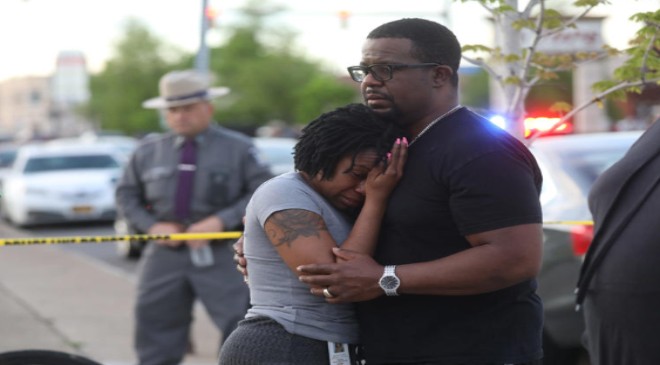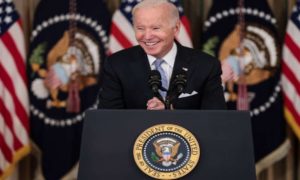Some do it out of a perverse desire to make a difference in the world. Others are driven by mental illness, pandemic isolation or social media influences that turn them into hateful and sadistic monsters.
But there’s one increasing commonality among America’s mass shooters: Their youth.
Emerging data shows that killers like the accused gunman in Monday’s Independence Day parade attack in Highland Park, Illinois, 21-year-old Robert “Bobby” Crimo III, are a lot younger on average than they used to be. And researchers are scrambling to understand why, in a desperate effort to stop the next one.
“They are trending younger. The ‘why’, of course, is going to take a bit more research,” said Katherine Schweit, a former FBI agent who until 2017 headed the bureau’s Active Shooter Program. “But it appears that so many of them are crying out for attention – living through pandemic stress and getting indoctrinated online. And, you know, looking to be famous.”
Uvalde shooting aftermath: Innocents lost: Uvalde attack leaves broken lives, fractured public trust
Just a decade or two ago, most mass shooters in the United States were disgruntled employees who shot up their workplace or killed acquaintances or family members after they snapped from anger or stress.
Today, a relatively new body of research is showing that one of the most pressing threats comes from angry young males who live with family and spend hours online with a community of others with shared grievances and an admiration for bloodshed.
Transitional teen years, pressures
Young men in America always have been susceptible to violence because they are at an age – usually late teens to mid-20s – when they are trying to fit in with their peers and, at the same time, find their place in the world. Oftentimes, they encounter rejection and alienation at the same time they are becoming independent of their parents and the social safety net.
Those pressures have been amplified over the past decade by internet and social media platforms where bullying and aggressive marketing of hateful ideologies – and weapons – is rampant, researchers and law enforcement officials told USA TODAY.
More recently, they say, the problem has been compounded by an intensifying mental health crisis that got exponentially worse during the pandemic-forced isolation.
“It’s really proliferating,” said Arie Kruglanski, a psychology professor at the University of Maryland who has spent decades studying mass violence and extremism.
The anecdotal evidence of the rise of the young male mass shooter is overwhelming, he says, even if few formal studies have officially quantified it.
Before the year 2000, there were about three mass shootings a year in the United States, Kruglanski said. In the first six months of 2022, he said, there have been more than 240. And while U.S. school shootings soared to about one a month in recent years, they have escalated to the point where one is occurring about once a week, he said.
USA TODAY defines a mass shooting as an incident where at least four people are hit with gunfire, even if there are no fatalities.
Young mass shooters are also now training their gunsights, increasingly, on targets other than schools, according to experts and law enforcement officials.
On Monday, police say, Crimo fired more than 70 shots from a rooftop, killing seven people and wounding nearly 40 more with a legally purchased assault-style rifle before fleeing. He was captured that evening after a manhunt.
Before Crimo’s alleged attack near Chicago, there were the two 18-year-olds accused of carrying out the massacres in Buffalo, New York, and Uvalde, Texas: Payton Gendron and Salvador Ramos. Both followed a similar path, openly sharing menacing thoughts online and buying semiautomatic rifles as soon as it was legal.
In March 2021, a 21-year-old man launched a deadly attack in a Boulder, Colorado supermarket. Another 21-year-old gunned down shoppers at a Walmart in El Paso, Texas, in August 2019, killing 22 and injuring 25. And a 19-year-old former student went back to Marjory Stoneman Douglas High School in Parkland, Florida, in February 2018 and killed 17 students and staff.
Younger, deadlier mass killers
It wasn’t always this way. Relatively few mass killings before the year 2000 were committed by men below the age of 21, according to available data.
In 1999, Columbine was one of the first, when two teenagers in trench coats, aged 18 and 17, roamed the Littleton, Colorado high school and mowed down 13 people. In 2012, a troubled 20-year-old killed 26 people, including 20 children, at the Sandy Hook Elementary School in Newtown, Conn.
Soon after his 21st birthday, Dylann Roof killed eight Black congregants of the Emanuel African Methodist Episcopal Church in Charleston, S.C., during Bible study in June 2015. And in April 2017, student gunman Seung Hui Cho, 23, rampaged through the Virginia Tech campus, killing 32 people.
To date, it has been impossible to find common threads that explain the motivations behind all or even some of America’s mass shooters, especially the young ones, according to analysis by researchers and law enforcement agencies.
Some young mass shooters were clearly suffering from mental illness, humiliation at the hands of school acquaintances or family, or felt victimized in some other way. Several, like the Sandy Hook, Virginia Tech and Uvalde shooters, killed themselves after murdering so many others.

Others, like Roof, were clearly motivated by racial hatred. The self-avowed neo-Nazi white supremacist later confessed to committing his crimes in the hope of igniting a race war in what many authorities said was an act of domestic terrorism.
The El Paso gunman chose a Walmart in a heavily Hispanic area after posting on the anonymous message board 8chan a 2,356-word “manifesto” containing anti-immigrant and racist rhetoric and a desire to divide the nation into territories by race.
The Violence Project, a nonprofit, nonpartisan U.S. research center dedicated to reducing violence in society, has studied the problem in depth and found 175 variables in 180 mass shooting cases.
The organization did find commonalities, according to a comprehensive national database of mass shootings that it has compiled with federal funding from the National Institute of Justice. For instance, more than 80% of mass shooters were in a noticeable crisis prior to their shooting, with many showing outward signs of increased agitation, the Project’s Mass Shooter Database found, according to data compiled from 1966 through 2019.
Many of them – including Crimo, authorities say – were obsessed with violence, other mass shootings and a wide array of conspiracies.
Other shooters, according to the Violence Project data, exhibited symptoms that were much harder to categorize. Psychosis played no role for nearly 70% of mass shooters, it found, although many mass shooters experienced feelings of suicidality either before or during their attack.
But one finding from the Violence Project is especially noteworthy given the most recent spate of shootings: Hate-motivated mass shootings and fame-seeking perpetrators have rapidly increased since 2015.
A ‘quest for significance’
Many mass shooters, especially young males in America, are driven by such an all-consuming desire to become recognized, or even famous, that it becomes a form of extremist radicalization, said Kruglanski, who directs the university’s Motivated Cognition Laboratory. At the lab, his team uses experiments, neuroscience techniques, computer modeling and text analyses to study what causes violent extremism.
Kruglanski said this kind of desire for fame and social worth is neither a sign of mental illness nor psychological pathology. It is something much more fundamental, he argued, and stems from the universal human quest for self-worth, and the hunger for acknowledgment and respect.
“The quest for significance is the most important human motive, the most important social motive – to have dignity, to be somebody, to matter, to gain attention,” he said. “And unfortunately, violence is one way, a kind of primordial way, of doing that.”
“This has been exacerbated by the fact that these shooters are gaining tremendous media attention, sometimes more than TV stars and film stars. And therefore they feel that doing it is a surefire way of gaining status and significance,” Kruglanski told USA TODAY.

This quest for significance and social worth appears acutely in adolescence, he said, when the momentous life transition between childhood and adulthood is complicated by soaring hormones, turbulent emotions and gnawing uncertainty.
“The fact that they’re getting younger just suggests that people of all ages are picking up on that idea that if you feel insignificant, if you feel frustrated, if you feel threatened or anxious about your place in the world, there is a way for you to becoming a superstar in the course of a few hours, by picking up a gun and shooting up people.”
Social media platforms that put a premium on popularity reinforce that narrative.
The recent Buffalo mass shooter was only the latest to livestream his attack on social media. That tactic was popularized by a gunman who livestreamed his murder of 51 people at two mosques in Christchurch, New Zealand, in 2019. Many recordings of it are still available online.
Kruglanski describes this online groupthink as a form of radicalization and extremism because the shooters, not unlike suicide bombers, are so driven by this quest that they completely disregard the fact that the victims are innocent people, including children.
“All that is suppressed,” he said. “It is forgotten at the time, where the only thing that counts is how to feed the quest for significance. And unfortunately, I think it’s spreading.”

An ‘echo chamber’ of violence
Brian Murphy, a former top FBI and Department of Homeland Security official, blamed much of the spike in young U.S. male mass shooters on social media, including Facebook, Twitter and the now-ubiquitous TikTok videos devoured by those under the age of 25.
“We cannot underestimate the ways in which social media serves to reinforce beliefs, including extreme violent ones,” said Murphy, who ran three of the largest investigative social media platforms for the FBI and then headed DHS’s social media intelligence branch during his 26 years in law enforcement. Since retiring last September, he has run similar operations at the UK-based private firm Logically.
“This is not a new phenomenon, but the trend is accelerating, and the outcomes are more deadly,” said Murphy, whose company works with private and government clients to weed out online extremism. “Young men find, in a self-imposed ever-shrinking online environment, an echo chamber of like-minded violent types who push out the people they do not agree with.”
Among their group of angry peers, a potential mass shooter’s grievances are normalized and even encouraged. Most participants in this kind of feedback loop will never act out physically. But some, Murphy said, become so detached from reality that they become convinced that they alone “have found out what must be done.”
And often, “what must be done” to correct some perceived injustice, is going on a shooting rampage and gaining the credit for addressing it, Murphy told USA TODAY.
By the time they are moved to action, young mass shooters are often convinced they have nothing to lose, Murphy said, in part based on Internet-driven narratives and groupthink.
“It is evident to me that unless something is done to change this trend line,” he said, “it will only get worse.”
Schweit, the former FBI active shooter coordinator, said she believes a different approach is needed given how different the new threat is from the traditional workplace attacks.
“The concern that I have, as a person who works in this field, is that we have more younger shooters but we have less reporting by their peers and family members – and they are the only ones who are going to be able to help us kind of quell this increasing onslaught,” said Schweit, who retired from the FBI five years ago to focus full-time on how to better educate American communities in identifying and stopping mass killers before they strike.
‘There’s too much out there’
One month after Uvalde massacre, President Joe Biden signed the most significant gun control bill in nearly 30 years, enhancing background checks on gun buyers 18 to 21 years old. The bipartisan legislation also encourages states to develop better “red flag” laws that would deny guns to people deemed to be dangerous.
But friends, family and online peers also have to be willing to step forward and sound the alarm, Schweit said, because many young potential mass shooters are suicidal and reaching out for assistance even if they are not aware of it.
“They’re crying out for help in a different way,” she said. “But they have the ability to cry out for help and commit a mass murder.”
Crimo, for instance, had so alarmed his family with violent threats in 2019 that they alerted police when the boy “said he was going to kill everyone,” authorities said Tuesday. Police removed 16 knives, a dagger and a sword from their residence but no criminal charges were filed.

Schweit, author of the 2021 book “Stop the Killing: How to End the Mass Shooting Crisis,” agrees that law enforcement – and social media and Internet companies – also must do better at catching – and flagging – the warning signs that always seem to precede a mass shooting by a young male assailant.
But relying on them is a guarantee of failure, Schweit said.
“It’s easy in an aggregate afterwards to say, ‘He posted this on some website,’ but the internet is as deep as the sand across the beaches of the world, she said. “It’s impossible to monitor, even if there was a legal way to do it, which there isn’t. There’s just too much out there.”
Making it harder is that oftentimes, including several recent attacks, mass shooters have posted threats and an intention to commit violence in private chat rooms or using encrypted apps.
Researchers and experts are working overtime to assess the data and get a handle on the problem, according to Schweit, Murphy, Kruglanski and others.
“But when we have a shooting every week or two shootings a week, the research is going to lag behind, and there’s no way that we can have the information that we want to have in order to tell us what we’re seeing in front of us.”























